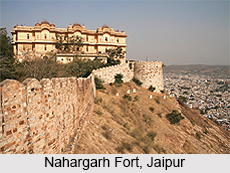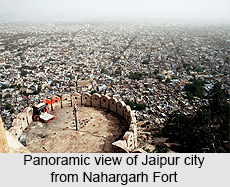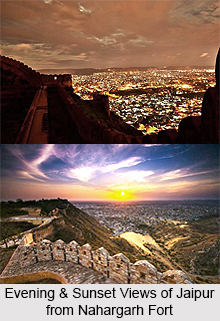 The royalty, gallantry and history symbolised by the culturally rich state of Rajasthan and its capital city Jaipur, are justified by the many forts and palaces that have been established through the chronicles of history, situated all across the state. Nahargarh Fort is one such prominent fort, standing atop the sheer rugged ridge of the Aravalli Hill Range, on its edge. The sturdy fort is famous for it offers an absolute spectacular panoramic view of the Pink City of Jaipur, being located atop a ridge of the Aravalli range on its edge and for its extensive wall that hooks it up to the celebrated Jaigarh Fort.
The royalty, gallantry and history symbolised by the culturally rich state of Rajasthan and its capital city Jaipur, are justified by the many forts and palaces that have been established through the chronicles of history, situated all across the state. Nahargarh Fort is one such prominent fort, standing atop the sheer rugged ridge of the Aravalli Hill Range, on its edge. The sturdy fort is famous for it offers an absolute spectacular panoramic view of the Pink City of Jaipur, being located atop a ridge of the Aravalli range on its edge and for its extensive wall that hooks it up to the celebrated Jaigarh Fort.
History of Nahargarh Fort, Jaipur
Nahargarh Fort was erected mainly in 1734 by Maharaja Sawai Jai Singh II, the founder of Jaipur. It once, along with the Amer Fort and the Jaigarh Fort, formed a strong defensive ring for Jaipur. Originally named as "Sudershangarh Fort", it was later renamed to Nahargarh, literally "dwelling of tigers". The fort"s name also has an interesting history to it, relating to a Rathore prince named Nahar Singh Bhomia, whose spirit, as legend has it, had haunted and thwarted the construction of the fort. The Maharaja discovered that the site where he was erecting the fort once belonged to the prince, who was disturbed with the sudden alteration in his holy dwelling.  The Maharaja got his spirit pacified by getting a small fortress built within the fort and dedicating it to the dead prince. Later a small temple was also built in that place, devoted to the prince. The fort is thus said to have come to be known by his name. The Nahargarh Fort was later refurbished in 1868 by Maharaja Sawai Ram Singh.
The Maharaja got his spirit pacified by getting a small fortress built within the fort and dedicating it to the dead prince. Later a small temple was also built in that place, devoted to the prince. The fort is thus said to have come to be known by his name. The Nahargarh Fort was later refurbished in 1868 by Maharaja Sawai Ram Singh.
Historical Events at Nahargarh Fort, Jaipur
Nahargarh Fort did not encounter any warfare during the course of its history, but it did observe a few key chronological events, like the treaties with the Maratha forces who had invaded Jaipur in the 18th century, and during the Sepoy Mutiny of 1857, throughout which it safeguarded the Europeans of the region, including the wife of a British resident, when they were moved inside the fort by Maharaja Sawai Ram Singh.
Attractions inside Nahargarh Fort, Jaipur
Between 1883 and 1892, several palaces and fortresses were built within the fort by Maharaja Sawai Madho Singh, such as the amusement palace Madhavendra Bhavan. The Nahargarh Fort, mainly used as a retreat for the imperial women folk, has this "zenana" (women quarters) Madhavendra Bhavan, a magnetic two-storey palace with fine interior work embellished with wall paintings and stucco patterns. Each and every suite of the Zenana is a portrayal of the splendour and sumptuousness of Rajputana sculpture. The Mardana Mahal in the fort served as the quarters of the noble men.
Intellectual Design of Madhavendra Bhavan, Nahargarh Fort
The Madhavendra Bhawan constitutes 12 identical suites of the royal women. Each of the 9 queens were offered a two-storey dwelling placed on the three sides of a rectangular quad and the private living accommodation of the Maharaja was constructed on the fourth side. The suites and rooms are connected to each other via hallways. The queens" quarters were structured in an intellectual manner such that the Maharaja could pay a visit to a queen without any knowledge of the other queens. Each of the 9 queens had their names inscribed on their doors. The resplendent Nahargarh Fort showcases Indo-European style of architecture, the core design of the suites being Indian and some European embellishments such as rectangular casements and European-styled lavatories were incorporated.
Although a major chunk of the fort is in damages today, the 19th century embellishments and the walls of the fort are still in good condition. Besides its interiors, the Nahargarh Fort offers picturesque visuals, overlooking the skyline and the Jaipur city from its elevation. Panoramic view of the Man Sagar Lake and arresting sunsets are also caught from the fort and its ramparts. The majestic fort was also the hunting place for the ancient Maharajas and their noble guests. Although the fort never encountered any attack or invasion, the defensive guns were occasionally fired from the fort, as an indication of time.
Nahargarh Fort was the shooting location for Bollywood films like "Rang De Basanti" and "Shuddh Desi Romance" and film of Bengali Cinema, "Sonar Kella". The fort remains open for visit on all days from 10 a.m. to 5 p.m. Visitors can access the escalated fort by an about 2 kilometre trek from the Nahargarh Fort road up to the top.



















